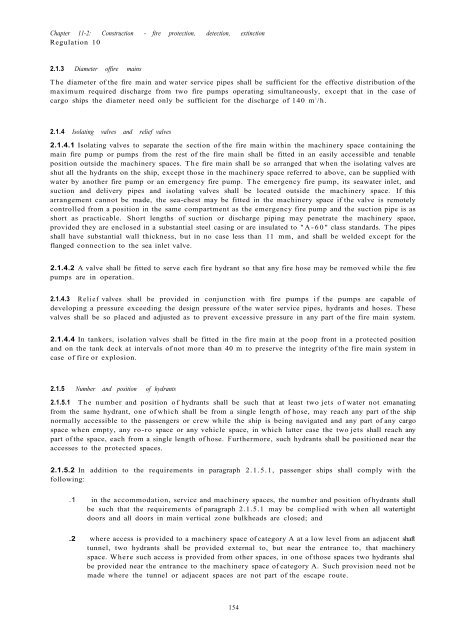Solas Consolidated Edition 2009.pdf
Solas Consolidated Edition 2009 for maritime
Solas Consolidated Edition 2009 for maritime
Create successful ePaper yourself
Turn your PDF publications into a flip-book with our unique Google optimized e-Paper software.
Chapter 11-2: Construction - fire protection, detection, extinction<br />
Regulation 10<br />
2.1.3 Diameter offire mains<br />
The diameter of the fire main and water service pipes shall be sufficient for the effective distribution of the<br />
maximum required discharge from two fire pumps operating simultaneously, except that in the case of<br />
cargo ships the diameter need only be sufficient for the discharge of 140 m 3 /h.<br />
2.1.4 Isolating valves and relief valves<br />
2.1.4.1 Isolating valves to separate the section of the fire main within the machinery space containing the<br />
main fire pump or pumps from the rest of the fire main shall be fitted in an easily accessible and tenable<br />
position outside the machinery spaces. The fire main shall be so arranged that when the isolating valves are<br />
shut all the hydrants on the ship, except those in the machinery space referred to above, can be supplied with<br />
water by another fire pump or an emergency fire pump. The emergency fire pump, its seawater inlet, and<br />
suction and delivery pipes and isolating valves shall be located outside the machinery space. If this<br />
arrangement cannot be made, the sea-chest may be fitted in the machinery space if the valve is remotely<br />
controlled from a position in the same compartment as the emergency fire pump and the suction pipe is as<br />
short as practicable. Short lengths of suction or discharge piping may penetrate the machinery space,<br />
provided they are enclosed in a substantial steel casing or are insulated to "A-60" class standards. The pipes<br />
shall have substantial wall thickness, but in no case less than 11 mm, and shall be welded except for the<br />
flanged connection to the sea inlet valve.<br />
2.1.4.2 A valve shall be fitted to serve each fire hydrant so that any fire hose may be removed while the fire<br />
pumps are in operation.<br />
2.1.4.3 Relief valves shall be provided in conjunction with fire pumps if the pumps are capable of<br />
developing a pressure exceeding the design pressure of the water service pipes, hydrants and hoses. These<br />
valves shall be so placed and adjusted as to prevent excessive pressure in any part of the fire main system.<br />
2.1.4.4 In tankers, isolation valves shall be fitted in the fire main at the poop front in a protected position<br />
and on the tank deck at intervals of not more than 40 m to preserve the integrity of the fire main system in<br />
case of fire or explosion.<br />
2.1.5 Number and position of hydrants<br />
2.1.5.1 The number and position of hydrants shall be such that at least two jets of water not emanating<br />
from the same hydrant, one of which shall be from a single length of hose, may reach any part of the ship<br />
normally accessible to the passengers or crew while the ship is being navigated and any part of any cargo<br />
space when empty, any ro-ro space or any vehicle space, in which latter case the two jets shall reach any<br />
part of the space, each from a single length of hose. Furthermore, such hydrants shall be positioned near the<br />
accesses to the protected spaces.<br />
2.1.5.2 In addition to the requirements in paragraph 2.1.5.1, passenger ships shall comply with the<br />
following:<br />
.1 in the accommodation, service and machinery spaces, the number and position of hydrants shall<br />
be such that the requirements of paragraph 2.1.5.1 may be complied with when all watertight<br />
doors and all doors in main vertical zone bulkheads are closed; and<br />
.2 where access is provided to a machinery space of category A at a low level from an adjacent shaft<br />
tunnel, two hydrants shall be provided external to, but near the entrance to, that machinery<br />
space. Where such access is provided from other spaces, in one of those spaces two hydrants shal<br />
be provided near the entrance to the machinery space of category A. Such provision need not be<br />
made where the tunnel or adjacent spaces are not part of the escape route.<br />
154


